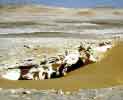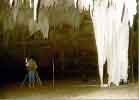
 |
|
The area of Djara was occupied during the Holocene wet phase. Surface sites show intensive activities during this time period. 14C-dates from archaeological excavations indicate occupation events about 8600-6000 BP (uncalibrated). The dripstone cave of Djara was used by the occupiers indicated by numerous depictions of game and people. The pictures were engraved and/or picked. The panels with depictions were surveyed and documented during the ACACIA expeditions in 1999 and 2000.
| (click to enlarge photos) | ||||
 Entrance of the cave |
 The large hall |
 The hall of the gazelles with decorated stalagmite (panel A) |
 Picked human figure from panel A |
 Depictions of oryx (?) from panel A |
Literature:
R. Kuper (1996) Between the Oases and the Nile - Djara: Rohlfs' cave in the Western Desert. In: L. Krzyzaniak/K. Kroeper/M. Kobusiewicz (eds.) Interregional Contacts in the Later Prehistory of Northeastern Africa. Studies in African Archaeology 5. Poznan: 81-91.
E. Claßen, K. Kindermann, A. Pastoors and H. Riemer (2001) Djara 90/1 - Felsbildhöhle und Fundplatz eines holozänen Gunstraums der Nordost-Sahara (Ägypten). Archäologisches Korrespondenzblatt 2001.
Authors and addresses:
| Karin Kindermann
M.A. Dr. Rudolph Kuper Dr. Heiko Riemer Heinrich-Barth-Institut e.V. Universität zu Köln Jennerstr. 8 D - 50823 Köln fst.afrika@uni-koeln.de |
Dr. Andreas Pastoors Neanderthal Museum Talstr. 300 D - 40822 Mettmann pastoors@neanderthal.de |
Erich Claßen M.A. Institut für Ur- und Frühgeschichte Universität zu Köln Weyertal 125 50923 Köln erich.classen@uni-koeln.de |
| [Main]
[Informations & Downloads] [Djara
- dripstone cave]
|